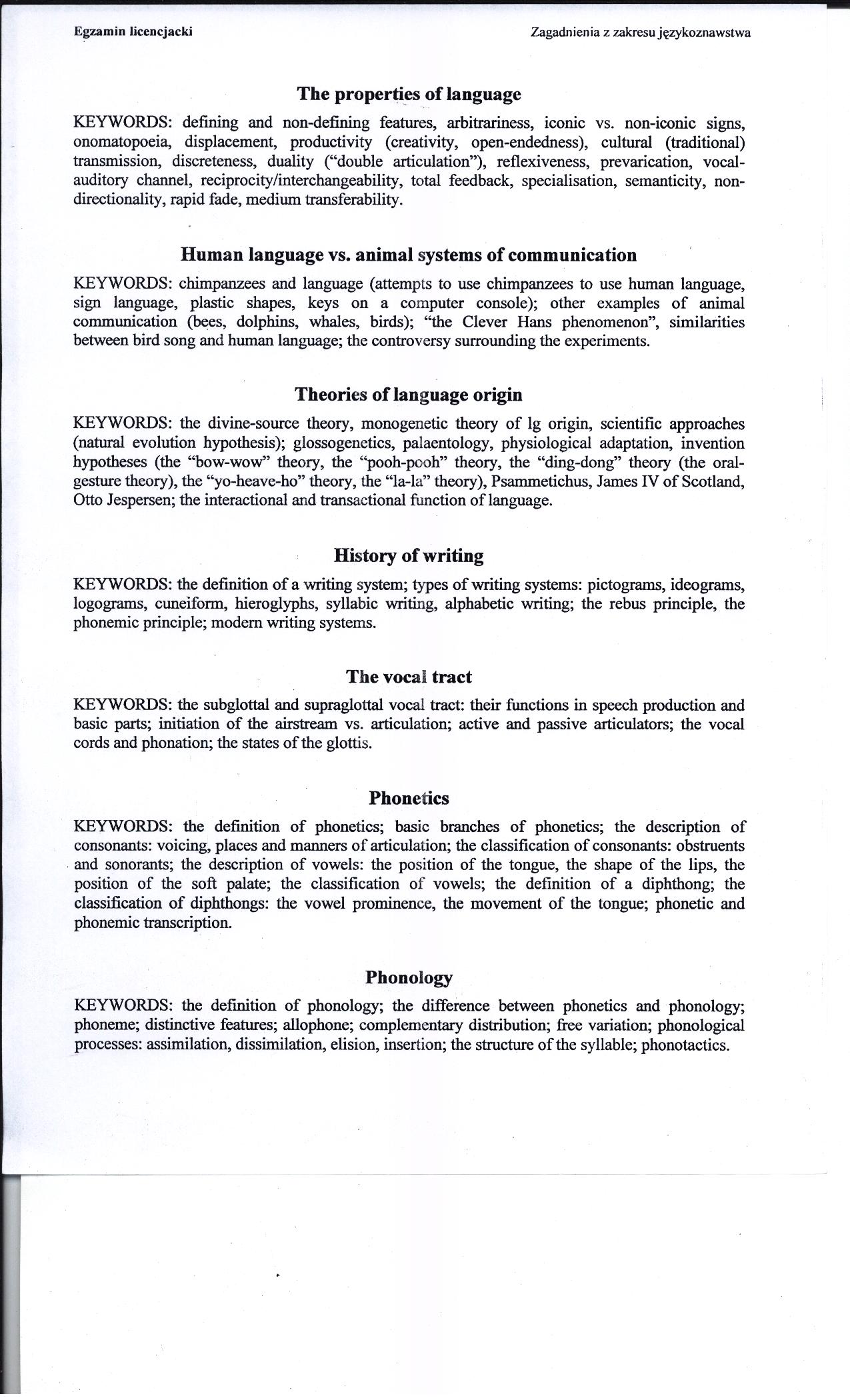Jŕzykoznawstwo licencjat 2

Egzamin licencjacki
Zagadnienia z zakresu językoznawstwa
The properties of language
KEYWORDS: defining and non-defining features, arbitrariness, iconic vs. non-iconic signs, onomatopoeia, displacement, productivity (creativity, open-endedness), cultural (traditional) transmission, discreteness, duality (“double articulation”), reflexiveness, prevarication, vocal-auditory channel, reciprocity/interchangeability, total feedback, specialisation, semanticity, non-directionality, rapid fade, medium transferabiłity.
Humań language vs. animal systems of communication
KEYWORDS: chimpanzees and language (attempts to use chimpanzees to use human language, sign language, plastic shapes, keys on a Computer console); other examples of animal communication (bees, dolphins, whales, birds); “the Clever Hans phenomenon”, similarities between bird song and human language; the controversy surrounding the experiments.
Theories of language origin
KEYWORDS: the divine-source theory, monogenetic theory of lg origin, scientific approaches (natural evolution hypothesis); glossogenetics, palaentology, physiological adaptation, invention hypotheses (the “bow-wow” theory, the “pooh-pooh” theory, the “ding-dong” theory (the oral-gesture theory), the “yo-heave-ho” theory, the “la-la” theory), Psammetichus, James IV of Scotland, Otto Jespersen; the interactional and transactional function of language.
History of writing
KEYWORDS: the definition of a writing system; types of writing systems: pictograms, ideograms, logograms, cuneiform, hieroglyphs, syllabic writing, alphabetic writing; the rebus principle, the phonemic principle; modem writing systems.
The vocai tract
KEYWORDS: the subglottal and supraglottal vocal tract: their functions in speech production and basie parts; initiation of the airstream vs. articulation; active and passive articulators; the vocal cords and phonation; the States of the glottis.
Phonetics
KEYWORDS: the definition of phonetics; basie branches of phonetics; the description of consonants: voicing, places and manners of articulation; the classification of consonants: obstruents and sonorants; the description of vowels: the position of the tongue, the shape of the lips, the position of the soft palate; the classification of vowels; the definition of a diphthong; the classification of diphthongs: the vowel prominence, the movement of the tongue; phonetic and phonemic transcription.
Phonology
KEYWORDS: the definition of phonology; the difference between phonetics and phonology; phoneme; distinctive features; allophone; complementary distribution; free variation; phonological processes: assimilation, dissimilation, elision, insertion; the structure of the syllable; phonotactics.
Wyszukiwarka
Podobne podstrony:
Jŕzykoznawstwo licencjat 3 Egzamin licencjacki Zagadnienia z zakresu językoznawstwaPsycholinguisti
Jŕzykoznawstwo licencjat 1 Egzamin licencjacki Zagadnienia z zakresu językoznawstwaMorphology KEYW
<ń e+efykaEGZAMIN LICENCJACKI 2015/2016ZAGADNIENIA Na egzamin obowiązują zagadnienia z
Edukacja geologiczno-inżynierska 77 studiach licencjackich geologią stosowaną) zagadnienia z zakresu
[SKREŚLONE] ART. 182 1. Licencję zawodową w zakresie pośrednictwa w obrocie
Specjalizacje na studiach licencjackich Biegła znajomość języków obcych - to szczególnie Cię wyróżni
P1010241 9. Postępowanie kwalifikacyjne w celu nadania licencji zawodowych w zakre
Zagadnienia , ZAKRES ZAGADNIEŃ EGZAMINACYJNYCHriz HISTORII LITERATURY STAROPOLSKIE
zagadnienia na egzamin 1. Podstawowe pojęcia z zakresu ekologii i ochrony środowis
Art. 187 Inżynier przestrzeni zurbanizowanej 1. Licencję zawodową w zakresie zarządzania
więcej podobnych podstron